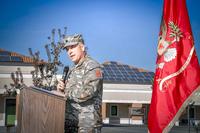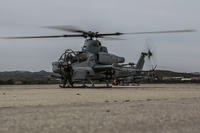U.S. warplanes and drones carried out a series of airstrikes Friday against fighters of the Islamic State of Iraq and the Levant threatening the Kurdish capital of Irbil in northern Iraq.
In quick succession, the U.S. airstrikes targeted an ISIL mobile artillery piece, a mortar position and a convoy of vehicles, said Rear Adm. John Kirby, the Pentagon press secretary.
The bombing began when two Navy FA-18 Super Hornets flying off the carrier George H.W. Bush in the Persian Gulf struck the first blows in the latest U.S. effort to create a stable and secure Iraq.
In an early morning strike, the F-18s dropped 500-pound, laser-guided bombs on mobile artillery pieces used by ISIL fighters who have surged to within 30 miles of Irbil.
In the next strike, remotely piloted aircraft, possibly Predators, hit a "terrorist mortar position. When ISIL fighters returned to the site moments later, the terrorists were attacked again and successfully eliminated," Kirby said in a statement.
The third strike consisted of four F-18s which attacked a parked ISIL convoy of seven vehicles and a nearby mortar position. "The aircraft executed two planned passes. On both runs, each aircraft dropped one laser guided bomb making a total of eight bombs dropped on target neutralizing the mortar and convoy," Kirby said.
In a White House announcement Thursday night, President Obama authorized airstrikes to protect U.S. personnel in Irbil and ease the plight of refugees threatened by ISIL, but the Pentagon officials stressed that the orders to the F-18s and the choice of target came from Army Gen. Lloyd Austin, head of the Central Command.
"The decision to strike was made by the U.S. Central Command commander under authorization granted him by the commander-in-chief," said Rear Adm. John Kirby, the Pentagon press secretary who was traveling with Defense Secretary Chuck Hagel in India.
F/A-18 Super Hornets also flew as escorts Thursday night with two C-130 and one C-17 cargo aircraft to make airdrops of relief supplies to thousands of members of the Yazidi sect trapped by the fighting on a mountain outside the northern town of Sinjar.
The cargo planes flew low in a 15-minute runs over the drop zone to deliver 72 bundles of food and water, including 8,000 Meals Ready to Eat (MREs), the Pentagon said.
The relief flights came from several U.S. bases in the region which the Pentagon declined to name. The U.S. has an airbase or airbase access in several countries in the region, including Turkey, Kuwait, Qatar and Jordan.
In authorizing the airstrikes, Obama became the fourth U.S. president in a row to initiate military action in Iraq over the course of the last 24 years following George H.W. Bush, Bill Clinton and George W. Bush.
ISIL spokesmen mocked the planned U.S. air campaign as being essentially useless against their street fighters.
"The planes attack positions they think are strategic, but this is not how we operate," an ISIL fighter told Reuters by telephone. "We are trained for guerrilla street war," the fighter said. "God is with us and our promise is heaven. When we are promised heaven, do you think death will stop us?"
A senior Obama administration official said that ISIL had begun "threatening the periphery of Irbil," prompting Obama's authorization of airstrikes. The U.S. maintains a consulate in Irbil and about 40 U.S. Special Forces troops are stationed there at a Joint Operations Center to aid the Kurds with intelligence and advice.
A second goal of the airstrikes was to break the siege of thousands of Yazidis on the mountain outside Sinjar by ISI, the official said.
Obama said that "These innocent families are faced with a horrible choice – descend the mountain and be slaughtered or stay and slowly die of thirst and hunger."
Beginning last Saturday, ISIL fighters launched a series of offensives that rolled up Kurdish towns and positions and by Wednesday night had come within 30 miles of Irbil, the senior official said.
"It is their mission to ethnically cleanse anyone they disagree with," the official said. "Literally, they were putting people's heads on pikes."
In addition to their brutality, ISIL fighters had shown that they were a "military proficient organization" capable of aggressive fire and maneuver with the support of indirect fire, the official said. They've made advances on both Kurdish and Iraqi military forces.
White House spokesman Josh Earnest on Friday said the U.S. military is authorized to support the Kurdish fighters – called the Peshmerga – if they believe the efforts will help dislodge militants from their siege of the mountain.
By many accounts, the Kurdish fighters have been the most aggressive and disciplined of any Iraqi force, but they have been forced to give ground to ISIL forces that have proven to be tougher and more organized than originally believed.
"In some locations, the Kurds have withdrawn against the better equipped and more agile [ISIL] forces," Earnest said. "[They] are a capable fighting force and continue to fight ISIL ... it may be necessary to provide support to enhance their position or take out key targets to help in their success."
The U.S. is pressing for more coordination between the Kurds and Iraq Security Forces and more progress in Iraqi establishing a government that reflects the diversity of the country, Earnest said. The ISF is limited as a fighting force in part because it "never integrated in a way that reflects Iraq's population, and that was a consequence of failed political leadership," he said.
Even as the Obama administration asserts the U.S. strikes will be limited, the American military has assembled a formidable force in the region, including about 31,000 service members, should the president decide to take more aggressive action.
Since ISIL fighters invaded from Syria in early June and took over a large swath of northern and western Iraq, the Navy has moved the aircraft carrier USS George H.W. Bush and her two escort warships – the cruiser USS Philippine Sea (CG 58) and the destroyer USS Truxtun (CGN 35) – into the Persian Gulf.
The Bush strike group has been joined by the amphibious assault ship Bataan with 1,000 Marines aboard, the transport dock ship Mesa Verde with 550 Marines aboard, and the destroyer O'Kane.
The Army has the 3,300 troops of the 2nd Combat Brigade of the 4th Infantry Division in Kuwait, and another 1,000 troops in Jordan. The troops in Jordan are protected by a detachment of F-16 fighters and Patriot anti-missile batteries.
However, Obama stressed Thursday night, and his Press Secretary Josh Earnest repeated several times Friday, that the U.S. has no intention of sending ground troops back into Iraq.
"What is not being contemplated is the introduction of American troops in a combat role," Earnest said.
-- Associate Editor Bryant Jordan contributed to this report.
-- Richard Sisk can be reached at richard.sisk@monster.com






























